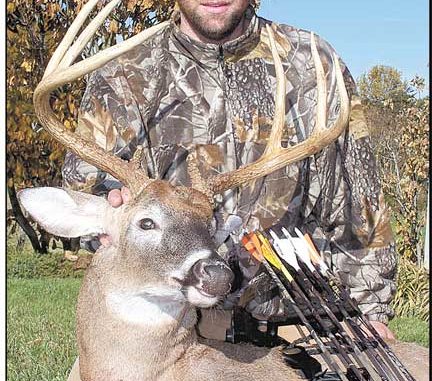
Scooter Pegg was named 2007’s bow hunter of the year by the Guilford Bowhunters.
The club utilizes a point system to determine the winner of this award.
Pegg, now 33, has been bow hunting since he was 12 and arrowed his first deer at the Sandhills Game Land during 1987 while hunting with his grandfather, Thomas Lawson.
His love of the sport hasn’t decreased.
“I hunt a lot,” Pegg said. “I may miss maybe eight or 10 days in the woods the entire season. Every day I get home from work, I shower and hit the woods.”
Pegg’s eldest son, Tory, 14, also bow hunts about twice a week after school and Saturdays. The youngster tagged his first deer with a bow, a six-point buck, during the 2007 season.
Pegg’s young son, Hunter, 12, has shot several deer with a gun but hasn’t started bow hunting. However, the junior-high schooler shot a 54-pound grass carp June 29, 2008.
Some hunters are consistently successful and Scooter Pegg is one of these people and he’s training his sons the right way.
Most hunters probably could name others who fit into this category at regular jobs, but that success doesn’t always apply to hunting. In-the-woods success they achieve often is attributed to luck.
If there is such a thing, luck comes into play in some situations. But people who are consistently successful at any endeavor are usually those who put a lot of time and effort into their tasks or hobbies — and that’s what creates their “luck.”
During the past 25 years in scoring deer and other animals for hundreds of hunters, I’ve had the opportunity to listen to many stories of successful hunts. Occasionally a hunter will tell me a simple account of a hunt that happened without much effort; i.e., without scouting or working to prepare a stand location, no extra effort at all.
Actually such stories are rare.
However, a select number of hunters are successful year after year, no matter what they’re hunting.
Randy Mabe also comes to mind when I review a mental list of consistently successful hunters.
When I listen to stories from such hunters, it becomes apparent why they are so successful. Each one hunter uses several or all of some specific techniques.
Here’s a short list of what they do on a regular basis:
• Practice shooting year round.
It’s vital to practice with a bow and arrow (but it applies to gun hunters as well). Good hunters know their weapons’ (and their own) limitations. They don’t try to exceed the capabilities of the weapon or their skills.
• Scout hunting areas. Scouting lands that’ll be hunted is a key on a year-round basis. Become familiar with deer and other wildlife movement patterns. Know where food sources are located and when. Know where bedding and secure areas are for deer and other wildlife. Hunt feeding areas and trails leading to bedding and secure areas but don’t intrude on those two areas. Infringe on sanctuaries, and wildlife, especially deer, seemingly vanish into thin air.
• Educate yourself. Read as many articles about hunting as you can find; talk to other hunters; share and exchange information with hunters learned while hunting.
• Mobility. Be prepared to deal with changing conditions, especially while in an elevated stand. Be ready to move to another location if conditions dictate or be prepared to stay where you are if that’s the best thing to do.
Plan alternate routes to stands depending upon wind direction and weather. Don’t use the same path too often to and from your stand. Try not to be predictable. A smart old whitetail is seldom predictable. That’s why he’s old.
• Flexibility. Be prepared to deal with a situation when it occurs. Be ready to deal with the unknown and unpredictable that can happen while in your stand. Have a plan for every imaginable situation and be ready to use it when the time arrives.
• Perseverance. Persistence and patience are difficult virtues to master. If you’ve done your scouting and homework and know that the area you’re hunting holds a nice buck, you must have the patience and will to stick with it throughout the entire season.
Maybe it’s just a good idea to read until it sinks in. It’s a tough thing to do but it’s what hunting is all about, especially bow hunting.
I’m sure the list could be longer, but these are the basics that seem to work best for the most successful hunters.
Pegg, who’d acquired a new bow for the 2006 hunting season, practiced Friday morning, Nov. 3, after Gander Mountain archery pro David Hendrix had set up the bow Thursday night.
That afternoon Pegg decided to try a late-afternoon hunt at woods where he’d seen lots of scrapes. Twenty minutes after climbing into his stand, at 4:30 p.m., he saw the big buck he was hunting, accompanied by a small six-pointer.
When Pegg came to full draw, the big buck took off, chasing the smaller one. Then the trophy deer stepped into a road bed 40 yards behind Pegg. The hunter tried a commercial grunt call to no avail, then decided to mouth a “snort-wheeze” of his own.
The buck came straight to him, stopped 4 yards in front of Pegg’s tree, looking down a hill. Pegg shot the deer, which turned out to be a Pope&Young qualifier at 127 2/8 inches. He later tagged a 121 3/8 P&Y deer, again using the “snort-wheeze” tactic.
Basically Pegg adapted to a changing situation to down his best whitetail.
His “snort-wheeze mouth call sound is done by saying “shuh, shuh, shoooo.” The first two syllables are short and stop abruptly, then continue the last syllable until you run out of breath.



Be the first to comment